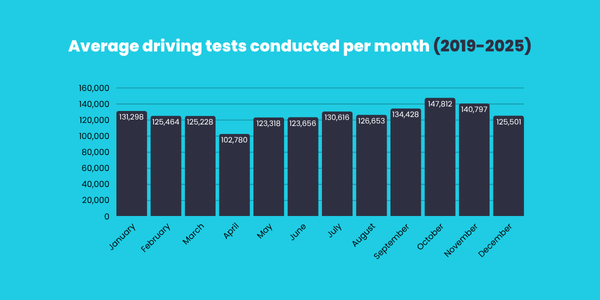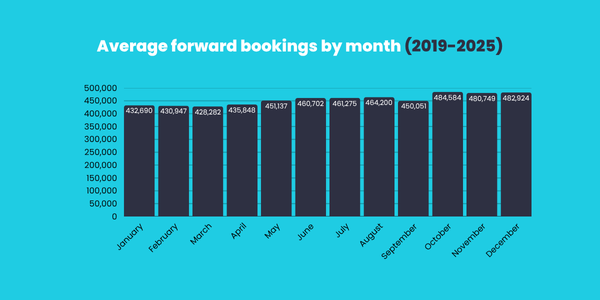
Driving Test Booking Changes For 2025 and 2026
Your guide to the latest driving test booking changes, new DVSA rules and measures aimed at cutting waiting times for learner drivers across the UK.
For many people across the UK, the practical driving test is one of the most significant milestones in life. Passing first time is what everyone will aim for, however it is important to consider what the actual pass rate is for the practical driving test and when is the best time of year to take it.
To help answer this, we’ve analysed DVSA driving test data between January 2019 and August 2025, covering over ten million driving tests across the country. This allows us to identify seasonal trends and highlight when most people take their test, along with which month gives you the best chance of passing.
Are you considering when to book your driving test? In this blog, we will explore which months see the most tests, and when you have the best chance of passing according to the average driving test pass rate.
You may assume that summer would be the peak season for driving test, because of the better weather and longer daylight hours. However, DVSA data on the number of driving tests conducted indicate otherwise, making some findings quite surprising.
When analysing the data, we can see that the number of driving tests conducted varies significantly by month. Looking at the DVSA data across the years 2019–2025, we calculated the average number of driving tests per month.

On average, the months with the most tests taken included:

Lower down the list, April is the clear outlier with the lowest average of ~102,780, making up just below 7% of the overall average amount. It is important to point out that this was mainly due to the impact of COVID-19 cancellations in April 2020 and 2021 dragging the average down.
From this data, we can see a clear seasonal pattern. October, November and September are all in autumn, showing this is a popular time for people to take their driving tests. This is likely due to people learning to drive in summer and then taking their test in autumn. Summer is a popular time for people to learn how to drive, either through driving lessons or private practice. Some learners choose to build their skills over spring and summer, helped by favourable weather, and are ready to take their test in the autumn. Another reason why the autumn is a popular time for driving tests, is that some learner drivers may want to take their test before it gets too dark in the winter months and before the festive period begins.
We then combined the DVSA data to calculate the average UK driving test pass rate per month from 2019 to 2025.

Here is what the data shows:

April stands out as the strongest month, with an average pass rate of 51.7%. This is partly explained by the disruption caused by COVID-19 in 2020 and 2021, when tests were delayed and only certain candidates were eventually able to sit them. Since less people were taking their test during the COVID-19 pandemic, this impacted the overall pass rate. February also performs strongly, averaging 51.4%.
At the other end of the scale, November and December see the lowest pass rates, averaging 47.7% and 48.1%, respectively. Shorter daylight hours mean more tests are taken in low-light or poor visibility, while wet and icy conditions add an extra challenge for learners. The run-up to the Christmas holidays can also create additional pressure, with test centre closures and potentially fewer appointment slots contributing to a more stressful experience.
Another useful measure in the DVSA dataset is forward bookings which essentially means the number of tests already scheduled at the end of each month. This gives a clear picture of demand and how it has changed over time.

The averages show a distinct seasonal trend:
The number of forward bookings and the driving test backlog has hugely significant implications for learner drivers:
To summarise, while demand is high year-round, the data makes clear that the end of autumn is the peak season for forward bookings, while late winter and early spring are comparatively quieter.
It is impossible to analyse this dataset without considering the pandemic’s effect. In 2020–2021, when fewer tests were being conducted, the pass rate spiked above 50%, far higher than the long-term average.
For example:
This happened because:
Post-pandemic, the pass rate has stabilised back to the long-term UK average of around 48%, showing that the brief increase was an anomaly rather than a lasting trend.
So, when is the best time to take your driving test in the UK?
Based on DVSA data (2019–2025):
While these seasonal swings are consistent, the gap between the best and worst months is only 3-4%. In practice, being well-prepared, confident, and consistent in your driving can have a far bigger impact on your result than the month you book.
Commonly asked questions about driving tests
The average UK driving test pass rate between 2019 and 2025 is around 48%.
Based on DVSA data, February, and April record the highest pass rates, both averaging just over 51%. March is also slightly above the yearly average.
Statistically, February and April are the best months, with March also performing well. That said, the differences are small and being well-prepared is far more important than timing.
Not significantly. While icy conditions may occasionally delay or cancel tests, DVSA data shows that pass rates remain consistent across the year.
Only about 48% of learners pass first time. Preparation and confidence are more important than test timing.
You will be logged out in seconds. Do you want to stay signed in?